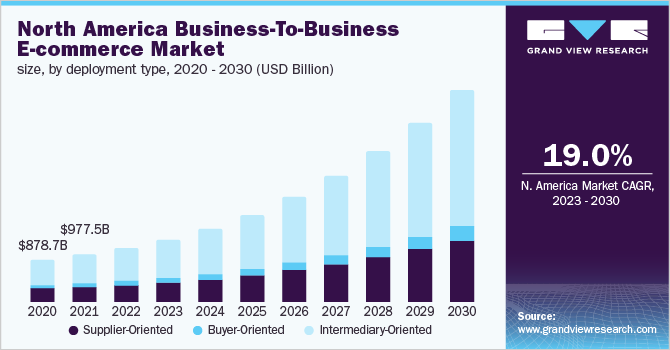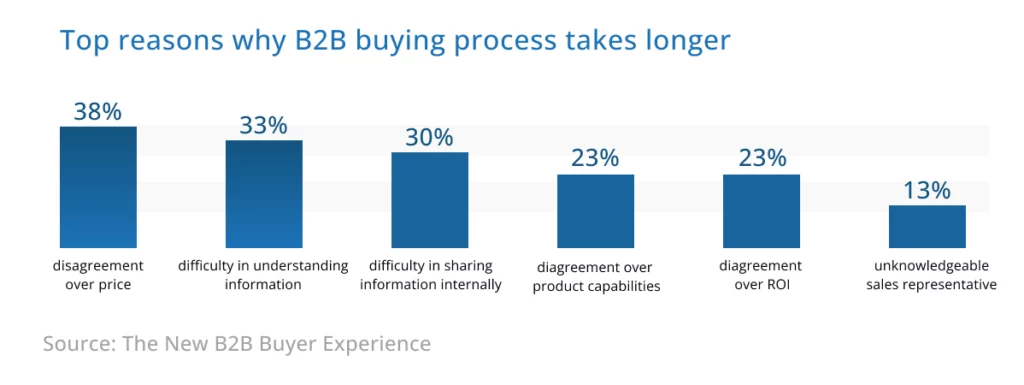The digital revolution has reshaped the landscape, not only for consumer-centric transactions but also for the often-overlooked domain of business-to-business (B2B) interactions. The advent of B2B eCommerce has ushered in a transformative era, redefining how businesses across industries engage, transact, and evolve.

B2B Ecommerce Myths:
1. Crafting amateur Instagram reels and sharing tweets can constitute effective digital marketing for B2B eCommerce.

Although sharing amateur Instagram reels and Tweets can be part of a B2B eCommerce marketing strategy, effective digital marketing in this sphere extends far beyond sporadic social media posts. Many wholesalers and manufacturers often struggle to initiate their digital marketing efforts.
Yet, the truth remains: without a robust digital marketing strategy and impeccable execution, merely dabbling in occasional postings won’t yield results, especially considering the increasingly competitive landscape.
The key lies in securing an exceptional digital marketing team. This team can aid in establishing a robust online presence, pinpointing the appropriate audience, fostering meaningful engagement, and ultimately converting B2B leads into valuable clientele.
For instance, Salesforce, a B2B software company, strategically utilizes a comprehensive digital marketing strategy encompassing targeted content, personalized campaigns, and social media outreach to engage with their B2B audience effectively. This approach has significantly contributed to their growth and market positioning.
2. Once you have a B2B eCommerce website set up, Sales Representatives may become unnecessary.

Despite establishing a B2B eCommerce website, the role of sales representatives remains crucial within your team due to the inherent complexities of B2B sales.
While the infographic below illuminates the challenges faced by B2B buyers, it’s imperative to recognize that unlike B2C transactions, B2B purchases significantly impact buyers over the long term.
Relying solely on an automated sales funnel may not yield optimal results, as purchase decisions in this domain are driven by trust and demand human interaction. However, a hybrid approach incorporating partial automation within your sales funnel can be beneficial. Once a lead matures, strategically assigning them to your sales representatives for personalized engagement and closing deals can be an effective strategy.
It’s essential to acknowledge that business transactions often involve nuanced reservations and specific requirements that surpass the capabilities of generic content or marketing strategies. Therefore, human intervention remains indispensable within eCommerce.”
An example of this lies within HubSpot, a software company. Despite their robust online platform, they heavily invest in a sales team that nurtures leads, offers tailored solutions, and guides clients through complex purchasing decisions, emphasizing the importance of human touch in their B2B transactions.

3. Commencing a business with high-profile clients right from the outset isn’t always feasible.

Contrary to the assumption that big-ticket clients solely favor established networks over eCommerce ventures, consider these compelling statistics:
- Millennials presently account for 73% of today’s B2B decision-makers involved in the buying process.
- A staggering 89% of B2B buyers actively utilize the Internet during the initial research phase of their purchasing journey.
These statistics underscore the pivotal role of the Internet in shaping product education and sales within thebusiness-to-business world. It’s evident that the online landscape plays an increasingly crucial role in influencing buying decisions.
In navigating this landscape, it’s paramount for your business website to boast impactful thought leadership content and valuable resources. These assets serve as essential tools in cultivating trust and credibility among prospective big-ticket clients, positioning your brand as a valuable resource in their decision-making process.”
An excellent real-life example demonstrating this shift is Shopify Plus, a B2B eCommerce platform. Despite being an online platform, Shopify Plus invests heavily in creating thought-provoking industry insights, case studies, and comprehensive resources on their website. These resources play a significant role in attracting and nurturing big-ticket clients, positioning Shopify Plus as a trustworthy and knowledgeable partner in the eCommerce landscape.
Learn abut B2B SEO here.
4. Your B2B eCommerce site should have a classic, professional appearance.

While established industry leaders may uphold a sluggish, archaic website design for the sake of brand recognition, as a new entrant in the digital sphere, there’s no necessity to adhere to outdated and mundane designs.
For a new business entering the online domain, it’s crucial that your website captivates and engages your visitors, setting you apart from the traditional norm.
Embrace modern technologies such as an AI-powered chatbot, a valuable tool aiding visitors in seamless navigation and access to vital information promptly. Moreover, the aesthetic appeal of your website is paramount. Invest in an engaging UI-UX design that adheres to principles of visual hierarchy, ensuring a user-friendly experience while enhancing the overall aesthetic appeal.
A real-life exemplar of this modern approach lies in Alibaba, a B2B eCommerce platform. Despite catering to a vast clientele, their website employs intuitive design elements, a user-friendly interface, and innovative features like AI-driven search and personalized recommendations. This approach sets them apart, showcasing that even in B2B eCommerce, a contemporary and engaging website is pivotal for user satisfaction and retention.
5. An eCommerce platform might not effectively represent B2B pricing structures.

While the notion of accommodating B2B pricing on eCommerce platforms might seem challenging initially, it’s entirely feasible and even advantageous. To effectively integrate B2B pricing on eCommerce websites, implementing account-based pricing catalogs stands as a fundamental step. These catalogs leverage historical data to offer tailored product suggestions and quantities based on individual accounts.
Furthermore, involving sales representatives in the process adds value. Enabling avenues for custom quotes and evaluating specific requirements enhances the purchasing journey, providing a personalized touch that aligns with the intricate nature of these transactions.
Strategic use of multiple filters and information fields is also essential. When thoughtfully sequenced, these filters aid in navigating the complexity of such purchases. They facilitate an organized and streamlined process without overwhelming users.
A prime example of this approach is Amazon Business, an extension of Amazon tailored for B2B transactions. They incorporate account-based pricing, customized quotes, and a user-friendly interface with extensive filtering options. This strategic integration showcases how eCommerce platforms can effectively cater to their pricing requirements, facilitating a seamless and personalized purchasing experience.
6. You cannot digitalize and automate customer service for your B2B eCommerce platform.

Automating customer service in eCommerce is invaluable, yet it’s crucial to recognize that complete automation may not suffice in this landscape, much like in sales.
While implementing self-service portals and AI chatbots plays a pivotal role in providing immediate information and assistance to visitors, human intervention remains indispensable in customer service.
It’s essential to strike a balance. Self-service tools and chatbots offer instant support, addressing common queries and facilitating seamless navigation. However, human customer service representatives provide a depth of support and understanding that automation can’t replicate. Identifying touchpoints where human intervention is critical is paramount. For complex inquiries, personalized assistance, or conflict resolution, human interaction holds significant value.
A stellar example is Cisco‘s customer service approach. Despite their advanced online support tools and chatbots for quick troubleshooting, they have a robust team of customer service representatives available for intricate technical inquiries and tailored guidance. This blend of automation and human touch ensures timely and effective customer service, addressing business-to-business eCommerce pain points while maintaining personalized support where needed.
7. Building a proper B2B eCommerce website is very pricey.

While the perception persists that constructing a B2B eCommerce website is exorbitantly expensive, it’s important to note that with the right approach, it can be a manageable investment.
Partnering with a reputable vendor is crucial. Look for a vendor capable of not only crafting a robust website structure but also offering comprehensive eCommerce-ERP integration services. This integration streamlines processes, optimizes conversions from inbound traffic, and automates sales and post-sales tasks extensively.
Furthermore, the vendor’s support doesn’t end at development; they must also provide maintenance and troubleshooting services. Downtime can significantly impact operations and revenue, emphasizing the importance of proactive maintenance to avoid potential costly disruptions.
A tangible illustration of this cost-effective approach is Magento Commerce, a platform offering customizable solutions for eCommerce. Their services cover website development, robust integration capabilities with ERP systems, and ongoing support to ensure seamless functionality. This holistic approach minimizes upfront costs while ensuring a reliable and scalable B2B eCommerce solution.
8. Neglecting mobile optimization for your B2B eCommerce website.

Disregarding mobile optimization in B2B eCommerce can be a costly oversight. Contrary to the belief that B2B transactions solely occur on computers, an increasing number of purchase cycles initiate on smartphones and traverse across multiple devices.
It’s paramount for your website not just to be visually appealing on mobile screens but to ensure seamless navigation and robust functionality. Consider the case of Alibaba, a prominent eCommerce platform. They prioritize mobile optimization, offering a user-friendly mobile interface that facilitates smooth transactions across devices, acknowledging the significance of mobile in these transactions.
9. Establishing personal relationships within B2B eCommerce is not feasible and valuable.

While personal relationships play a vital role in B2B transactions, an eCommerce website can remarkably augment this process. Addressing the primary concern of instant information access for buyers is crucial.
Grainger operates a robust eCommerce platform where B2B buyers can access their extensive catalog, check product specifications, compare prices, view inventory availability in real-time, and place orders directly. For instance, a facilities manager at a manufacturing plant urgently needs specific safety gear following an unexpected equipment breakdown. Instead of waiting for a sales representative, they can quickly log into Grainger’s website, locate the needed safety equipment, check its certifications and availability, and place an order instantly.
10. Creating a B2B eCommerce website is a one-time task.

Developing a B2B eCommerce website isn’t a one-time endeavor. Unlike static businesses, the dynamics of user behavior, market trends, and organizational growth dictate the need for periodic updates.
SAP‘s B2B eCommerce website serves as a hub for businesses seeking their software solutions. Over time, SAP continually updates its platform to adapt to evolving user behaviors, market trends, and organizational growth.
Initially, the website might have started with a basic layout showcasing their product offerings. However, as user behavior data revealed patterns, SAP would analyze how visitors interacted with the site—what pages were most popular, where users tended to drop off, or which features garnered the most attention.
Moreover, market trends play a crucial role in shaping SAP’s eCommerce strategy. As new software innovations emerge or industry-specific demands evolve, SAP would adapt its platform accordingly. For instance, if there’s a growing demand for AI-driven analytics tools in the market, SAP might introduce a dedicated section highlighting these offerings or incorporate personalized product recommendations based on industry-specific needs.
Conclusion:
As the B2B landscape continues to evolve, it’s imperative to question assumptions, seek knowledge, and adapt to the changing dynamics. Dispelling myths and embracing realities positions businesses to harness opportunities, drive innovation, and thrive in the ever-evolving world of B2B commerce.
FAQs on B2B eCommerce:
Is developing a B2B eCommerce website a one-time task?
No, it’s an ongoing process. Continuous updates, improvements, and adaptations are necessary to stay competitive and meet evolving customer needs.
How can automation benefit customer service in B2B eCommerce?
Automation streamlines processes, providing faster responses, efficient query handling, and 24/7 availability, enhancing the overall customer service experience.
Why is a professional appearance important for B2B eCommerce websites?
A professional appearance instills trust and credibility among potential clients in the B2B sector. It reflects reliability and competence, essential factors in business-to-business transactions.



